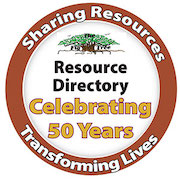Silver Valley woman leads challenge to lead contamination in area
 |
| Barbara Miller visits contaiminated site near Cataldo Mission. |
Concerned about people in the Silver Valley living with lead poisoning for generations, then being intimidated, shouted down and discouraged from addressing their living conditions, Barbara Miller came home 30 years ago as a community organizer.
In 1986, Idaho Fair Share received a grant from the Catholic Campaign for Human Development to address the devastation in the Silver Valley through grassroots organizing.
Through her leadership of the Silver Valley Community Resource Center (SVCRC) in Kellogg, she helps people address conditions that affect residents’ lives and health.
“We’re entitled to pursuit of happiness and freedom of speech, and people here are willing to work to improve their lives,” she said.
She heads this effort to clean up the Bunker Hill Superfund site and the Coeur d’Alene Basin, and to bring adequate health care to the Silver Valley in the form of a Community Lead Health Clinic/Center.
Many who rely on tourism in the region downplay the toxic waste. Barbara and those with whom she labors, however, continue to work for environmental justice and health care related to lead poisoning. She also works for decent housing, care for the homeless and economic development in a seriously depressed area.
The 21 square miles of the Bunker Hill site were placed on the Environmental Protection Agency (EPA) National Priority List in 1983.
The area had a 30 percent unemployment rate. It had been designated the second largest Superfund site in the nation. Generations of people dealt with chronic health issues from poisoning from lead and other heavy metals.
“This isolated company town had no help for people, who were being deceived about what was going on with their lives. The grant put me here to find the cause of the conditions,” she said. “I spent six months talking to people to determine how they wanted to improve the quality of life here. They accepted the outreach, the grant and my ability to bring them together.”
The SVCRC participants include church leaders, unions, social justice advocates, local people, social service groups and a network of health professionals and environmental justice representatives.
In 2000, the EPA extended the boundaries of the Superfund site to include 1,500 more square miles. The Coeur d’Alene Basin site runs from the Montana border into Eastern Washington, following the Coeur d’Alene River into Lake Coeur d’Alene and then into the Spokane River.
Stacks of paper cover every bookcase, desktop and table in the resource center’s office, detailing years of work to make the EPA live up to its directive to clean up the site.
Major tomes describe studies of the environmental impact of the pollution and how best to clean it up. Newspaper articles and records detail SVCRC actions over the years, and the push-back and threats they have received.
The SVCRC has focused on four priorities: 1) to shut down the repositories, especially at East Mission Flats (EMF); 2) to replace them with permanent waste technology; 3) to fund a Community Lead Health Center, and 4) to employ community people to do this.
The EPA chose to place the EMF repository across Interstate 90, 1,500 feet from the Sacred Heart Mission at Cataldo, the oldest building in Idaho and a National Historic Landmark. Built in the late 1800s by the Catholic Jesuits and the Coeur d’Alene and Flathead Native American tribes, the mission is on sacred land.
“At the base of the mission is a visitors center,” Barbara said. “During spring run-off, it floods almost to the doors. The Coeur d’Alene Tribe decontaminated the grounds in the fall of 1987. The next spring, it was re-contaminated. In 2011, 160 metric tons of contamination washed downstream during a flood. The repository does not belong there.”
For the clean-up work, the resource center has worked with the EPA to make sure local people receive the jobs.
Barbara said the SVCRC encourages the EPA to use better remediation techniques—in particular, permanent waste technology— but to no avail.
Permanent waste technology includes burying soundly encapsulated contaminated soil. Vitrification would burn the contamination off at very high heat. It is also possible to wash the soil and plant vegetation, such as iris bulbs or certain non-edible mushrooms that absorb the pollution, she said.
The resource center works with the Environmental Protection Agency to carry out its mandate to help residents clean up their homes.
Barbara described the piecemeal effort: One yard is decontaminated, but the one next door is not. The yard of one apartment complex has been remediated three times because contamination comes back.
Dust blows off trucks on their way to the repositories, blows off hillsides, or is kicked up in the clean-up process.
The EPA also is mandated to help residents clean their home interiors.
Barbara said that has not happened, even though “an official document says homes in the 21-square-mile Bunker Hill epicenter have two to 50 times more lead in them than do the yards.”
Lead is in furnaces, attics, carpets, crawl spaces and ducts. People ingest it, said Barbara, citing scientific data.
A 2005 National Academy of Science report on the Coeur d’Alene Basin Superfund Site also recommends ways the EPA should protect and improve human health and the environment there: 1) provide universal blood-lead testing for children from one to four; 2) increase long-term funding for human health intervention, and 3) assess the contribution of dissolved metals in groundwater.
Barbara said the EPA has tested only a handful of young children for blood-lead levels, using old guidelines, not the current, more stringent ones.
“Parents receive a letter that they don’t understand, with inadequate advice, such as to damp mop their floors and make sure their children’s hands are washed,” Barbara said. “I’ve been in most homes in the Silver Valley. I know dust is tracked in, re-contaminating the homes.”
The Panhandle Health District recently published a coloring book called “Eat Clean, Keep Clean, Play Clean.” While making good suggestions, it also encourages children and families to visit the Old Mission State Park, which is contaminated. Barbara considers that irresponsible.
The SVCRC’s current “Children Run Better Unleaded” is their most successful tool for lead education. It is on Facebook
The SVCRC has repeatedly sought to establish a Community Lead Health Clinic/Center. Experts have drawn up a plan, but the EPA has not acted on it.
“We interviewed people in 250 households, one of the area’s broadest surveys. Responders said 30 percent of the children have trouble reasoning; 40 percent are in special education, and 80 percent affirmed they would use a clinic,” Barbara said.
A health center could provide state-of-the-art care, as well as other economic and cultural programs, and professional health referrals that would improve the quality of life.
After 30 years, Barbara finds it hard to convince people to keep fighting.
“They are tired. They’ve been intimidated and ignored. They feel beaten down,” she said. “We have to continue to empower them.”
Barbara perseveres because she was brought up to treat people with respect.
“If we don’t have the environment, Mother Earth, we don’t have anything. I draw on spirituality and facts, believing in people and believing a better way of life will prevail. People deserve it. As long as I can continue, I will,” she said.
“I pray a lot and count on divine intervention. That’s where so much comes from in life. We pick ourselves up and find new approaches. We keep working until enough of the right people understand,” said Barbara.
For information, call 208-784-8891, email svcommunityresourcecenter@airpipe.com or visit silvervalleyaction.com.
Copyright © February 2016 - The Fig Tree






